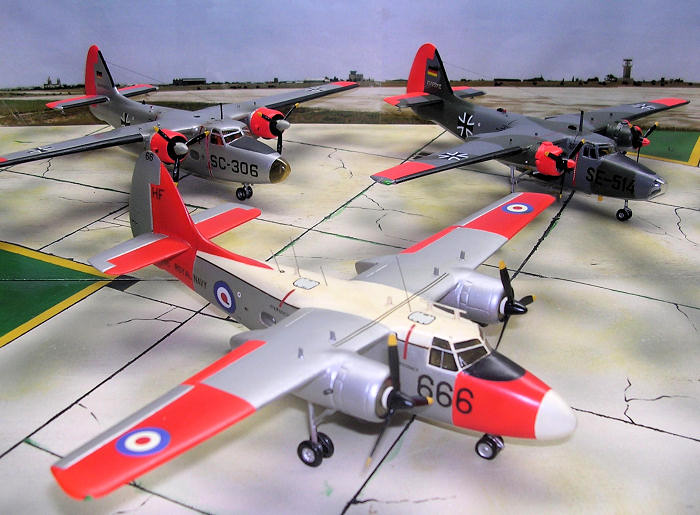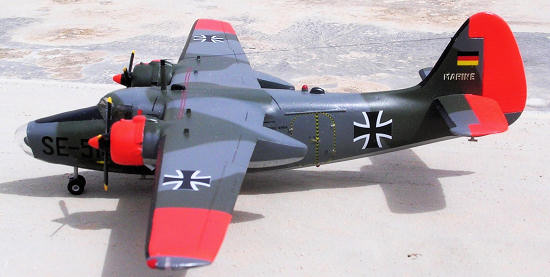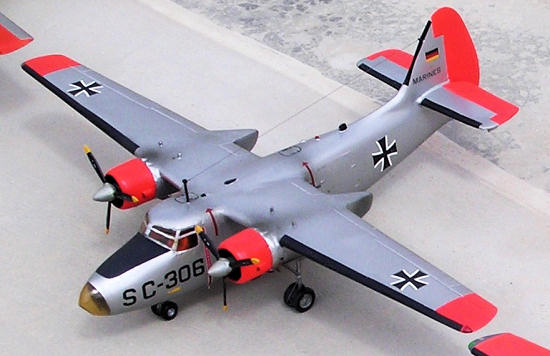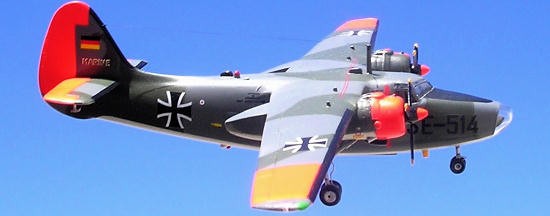
Airmodel 1/72 Pembroke/Sea Prince
| KIT #: | 168 |
| PRICE: | 9.5 Euros |
| DECALS: | None Provided |
| REVIEWER: | Carmel J. Attard |
| NOTES: | Basic Vacuform kit. |

| HISTORY |
 The military version of the civil
Percival Princess was sold abroad in fairly large numbers for training, aerial
survey, and communication duties following an intensive sale campaign. At the
time the then
The military version of the civil
Percival Princess was sold abroad in fairly large numbers for training, aerial
survey, and communication duties following an intensive sale campaign. At the
time the then
| THE KIT |
 One
of the most prolific of vacuum manufacturers is the German firm of Airmodel.
Apart from being one of the Pioneers in this field it used to have a very
comprehensive list of complete aircraft kits and conversion kits to its credit.
Airmodel has since deviated into producing prolific resin kits in addition to
several of the earlier vac-form kits. One of the earlier releases and which is
still available is the Percival Pembroke. Although not a straight forward kit to
make and therefore represents something of a challenge even to experienced
modellers it comes at a very reasonable price and with a little alteration and
detailing it can be turned into a Pembroke up to the standard of nowadays.
One
of the most prolific of vacuum manufacturers is the German firm of Airmodel.
Apart from being one of the Pioneers in this field it used to have a very
comprehensive list of complete aircraft kits and conversion kits to its credit.
Airmodel has since deviated into producing prolific resin kits in addition to
several of the earlier vac-form kits. One of the earlier releases and which is
still available is the Percival Pembroke. Although not a straight forward kit to
make and therefore represents something of a challenge even to experienced
modellers it comes at a very reasonable price and with a little alteration and
detailing it can be turned into a Pembroke up to the standard of nowadays.

By current standard the kit is somewhat basic, lacking parts for the undercarriage and propellers. These have to be found in the ‘Spares Box’ or otherwise manufactured from scratch. The kit comes on a single sheet of white acetate, which carries the two fuselage halves, 4 main plane parts, 4 tail plane parts and 4 engine nacelle halves. The cockpit, nose clear part and set of side windows for the fuselage comes in thick clear acetate. The instruction sheet depicts an exploded view indicating how the 18 parts kit go together and also suggest four colour schemes which include two German machines, one being silver overall finish and the other in camouflaged form. A clear sketch of the undercarriage and propeller gives indication of their size and shape so that one can make his own.
| CONSTRUCTION |
The Airmodel Pembroke was the
first of its type to appear on the market in kit form and being a popular
aircraft in European skies it must have been the attraction to many. I have
built three Airmodel Pembroke kits, one of which was converted to a Sea Prince
which had clipped shorter wings, while the other two were made into a C Mk 54.
The Sea Prince were based at Hal Far for a good number of years where they
served as a navigation and signals training 750 squadron, for Royal Navy new
recruits. My second
 Pembroke
was built as all silver with day-glow areas, a type in service with the German
Navy and my more recently built one was made as a C Mk54, camouflaged and with
day-glow areas again a German Navy machine.
Pembroke
was built as all silver with day-glow areas, a type in service with the German
Navy and my more recently built one was made as a C Mk54, camouflaged and with
day-glow areas again a German Navy machine.
Just like any vac form kit, the
parts are scribed around with a sharp Exacto blade and broken away from the
sheet in the normal way. The next stage is the rubbing down, removing the excess
plastic in doing so. This is done on a piece of wet and dry paper secured to a
board. The cabin windows moulded on fuselage halves are drilled and filed out to
shape. I did not use the clear thick plastic windows provided but left them open
until a later stage to glaze them with Kristal Kleer.
 Cockpit interior painted and crew inserted on their
seats. Cockpit canopy was cut and trimmed to fit. The nose Perspex incorporating
a part of the forward nose area was fitted. This component came from a spare
nose that came with the Special Hobby kit and replaced the vac for kit one, as
it was too narrow. Again this was faired using Plasto putty. The engine nacelles
were too small at the rear and were each built up with plastic card and faired
with putty so that the shape conforms to the profile appearing on the issue of
Aviation News. To provide a rigid wing to fuselage joint a wing spar made by
cutting a section from plastic sheet aprox 85mmx 5mm depth. Slots cut in wing
shoulder at their thicker spot and the spar is pushed through and glued at right
angles to the fuselage. The spar now serves to locate port and starboard wings,
which were then glued to the fuselage making sure there is correct alignment.
Port and starboard tail-planes also added and the engine nacelles, with reshaped
rear, are cemented in place. The undercarriage that was made out of sprue of
correct thickness and wheels added etc was stuck in place in the nacelles and
nose area. Only small wheel well doors for all three undercarriage legs remain
open, doors being made from thin plastic card. Propeller blades were cut from
plastic card and the hub was shaped from a thick sprue using a file and these
were assembled to form two 3-bladed propellers.
Cockpit interior painted and crew inserted on their
seats. Cockpit canopy was cut and trimmed to fit. The nose Perspex incorporating
a part of the forward nose area was fitted. This component came from a spare
nose that came with the Special Hobby kit and replaced the vac for kit one, as
it was too narrow. Again this was faired using Plasto putty. The engine nacelles
were too small at the rear and were each built up with plastic card and faired
with putty so that the shape conforms to the profile appearing on the issue of
Aviation News. To provide a rigid wing to fuselage joint a wing spar made by
cutting a section from plastic sheet aprox 85mmx 5mm depth. Slots cut in wing
shoulder at their thicker spot and the spar is pushed through and glued at right
angles to the fuselage. The spar now serves to locate port and starboard wings,
which were then glued to the fuselage making sure there is correct alignment.
Port and starboard tail-planes also added and the engine nacelles, with reshaped
rear, are cemented in place. The undercarriage that was made out of sprue of
correct thickness and wheels added etc was stuck in place in the nacelles and
nose area. Only small wheel well doors for all three undercarriage legs remain
open, doors being made from thin plastic card. Propeller blades were cut from
plastic card and the hub was shaped from a thick sprue using a file and these
were assembled to form two 3-bladed propellers.| COLORS & MARKINGS |

 Pembrokes landing at Hal-Luqa and these were:
Pembrokes landing at Hal-Luqa and these were:
| CONCLUSIONS |
| REFERENCES |
If you would like your product reviewed fairly and quickly, please contact me or see other details in the Note to Contributors.